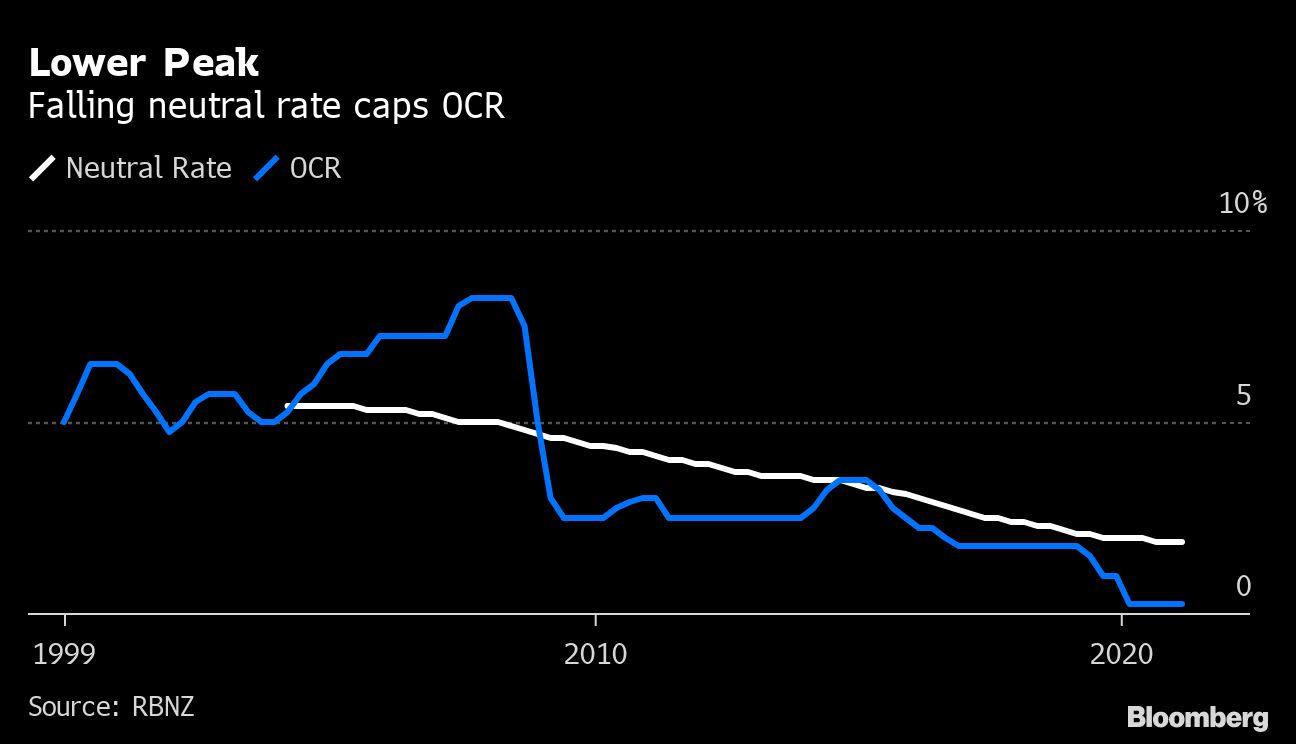Even With Hikes, RBNZ Will Likely Keep Rate at Historic Lows

(Bloomberg) — Sign up for the New Economy Daily newsletter, follow us @economics and subscribe to our podcast.
New Zealand’s central bank is poised to become one of the first in the developed world to raise interest rates after the Covid-19 pandemic, but it’s unlikely to take them anywhere close to the peaks seen in previous cycles.
The official cash rate, currently at a record-low 0.25%, won’t rise above 2% in coming years and may stay as low as 1.25%, according to a Bloomberg survey of nine economists. The benchmark rate rose to 6.5% in 2000, 8.25% in 2007 and 3.5% in 2014.
“Certainly the peak is going to be lower than anything we’ve seen in the past,” said Nick Tuffley, chief economist at ASB Bank in Auckland, who sees the OCR going no higher than 1.5% this cycle. “When you’re coming from a very low interest rate base, even a 0.25% increase in mortgage rates has a big impact. People could be very sensitive to higher rates so you don’t need to push them up quite so much.”
The Reserve Bank is expected to start lifting borrowing costs as soon as next month after it announced Wednesday it is halting quantitative easing in the face of “more persistent” inflation pressure. New Zealand’s economy is running hot after more than a year of ultra-loose monetary and fiscal policy, with strong demand starting to drive up consumer prices.
Inflation surged to 3.3% in the second quarter, breaching the RBNZ’s 1-3% target range for the first time in 10 years, a report Friday showed.
But while some analysts now predict two quarter-point rate increases this year, several also expect the pace of subsequent moves to be more gradual as the central bank takes time to gauge the effect of its tightening.
Neutral Rate
Higher interest rates are expected to have a big impact on consumers and businesses who have loaded up on cheap debt during the pandemic. House prices in particular have soared, saddling buyers with huge mortgages. That means the RBNZ may be able to achieve what it wants with the OCR at a lower level than was needed in the past.
The so-called neutral interest rate — the level that neither stimulates nor curbs economic activity and inflation — has also dropped markedly in recent decades due to a host of factors including globalization and an aging population.
In May, the RBNZ estimated that the neutral rate had fallen to 1.9% from 5.4% in 2004.
Bank of New Zealand economists expect the OCR to rise to 2% by early 2023, effectively removing monetary stimulus but not applying the brakes.
There are risks to that outlook in both directions, said BNZ rate strategist Nick Smyth.
Even modest rate hikes might have a powerful dampening effect on household spending and house prices could fall, reducing the eventual peak in the OCR, he said. On the other hand, a rapid global economic recovery and eventual reopening of borders could require it to go higher.
“There is a risk that the RBNZ needs not just to get the OCR to neutral, but to take it to ‘restrictive’ levels to cool an overheated economy and get inflation back to target,” Smyth said. “This would imply a risk that the OCR eventually needs to go higher than 2%.”
(Updates with inflation surge in fifth paragraph)
More stories like this are available on bloomberg.com
Subscribe now to stay ahead with the most trusted business news source.
©2021 Bloomberg L.P.




